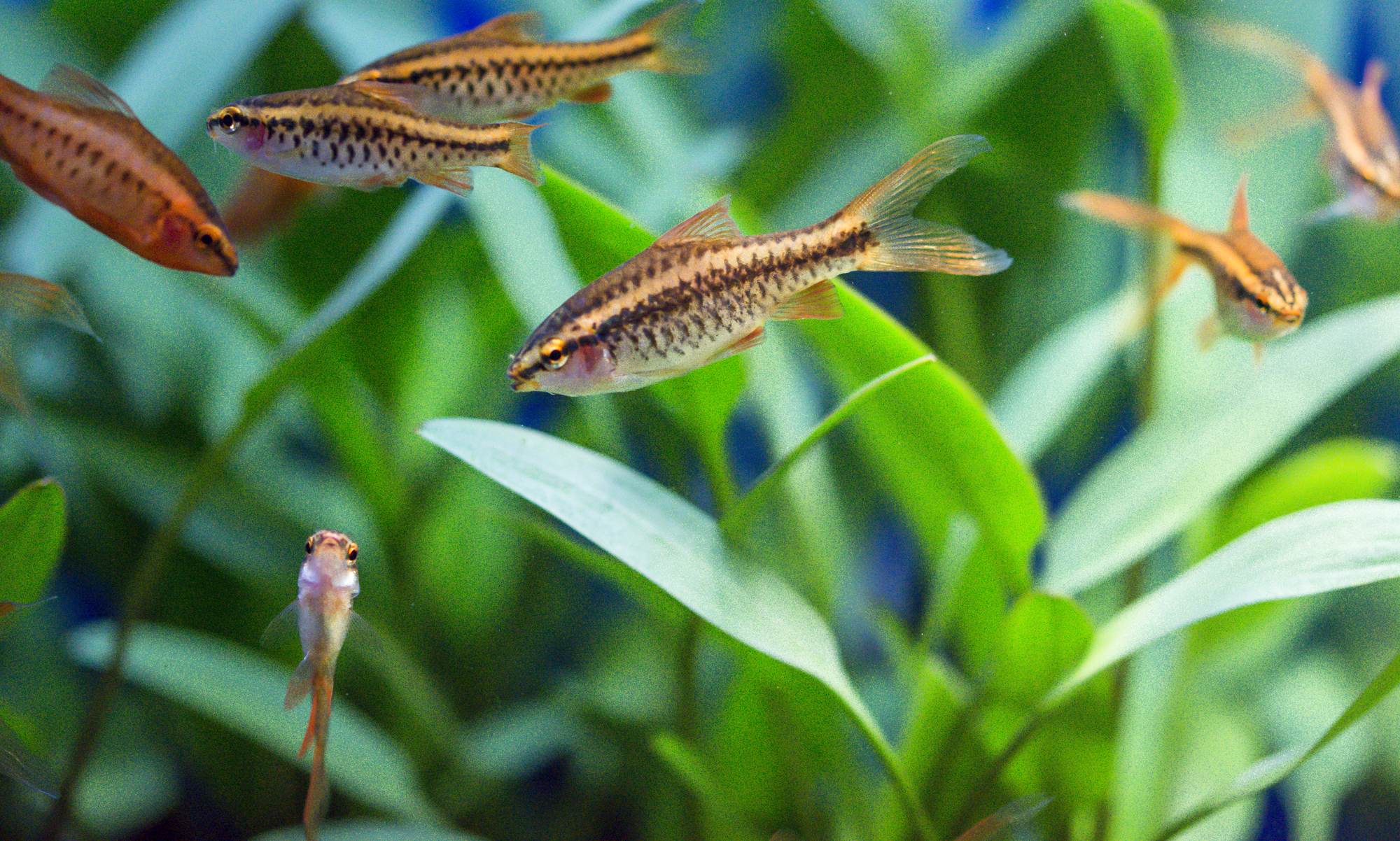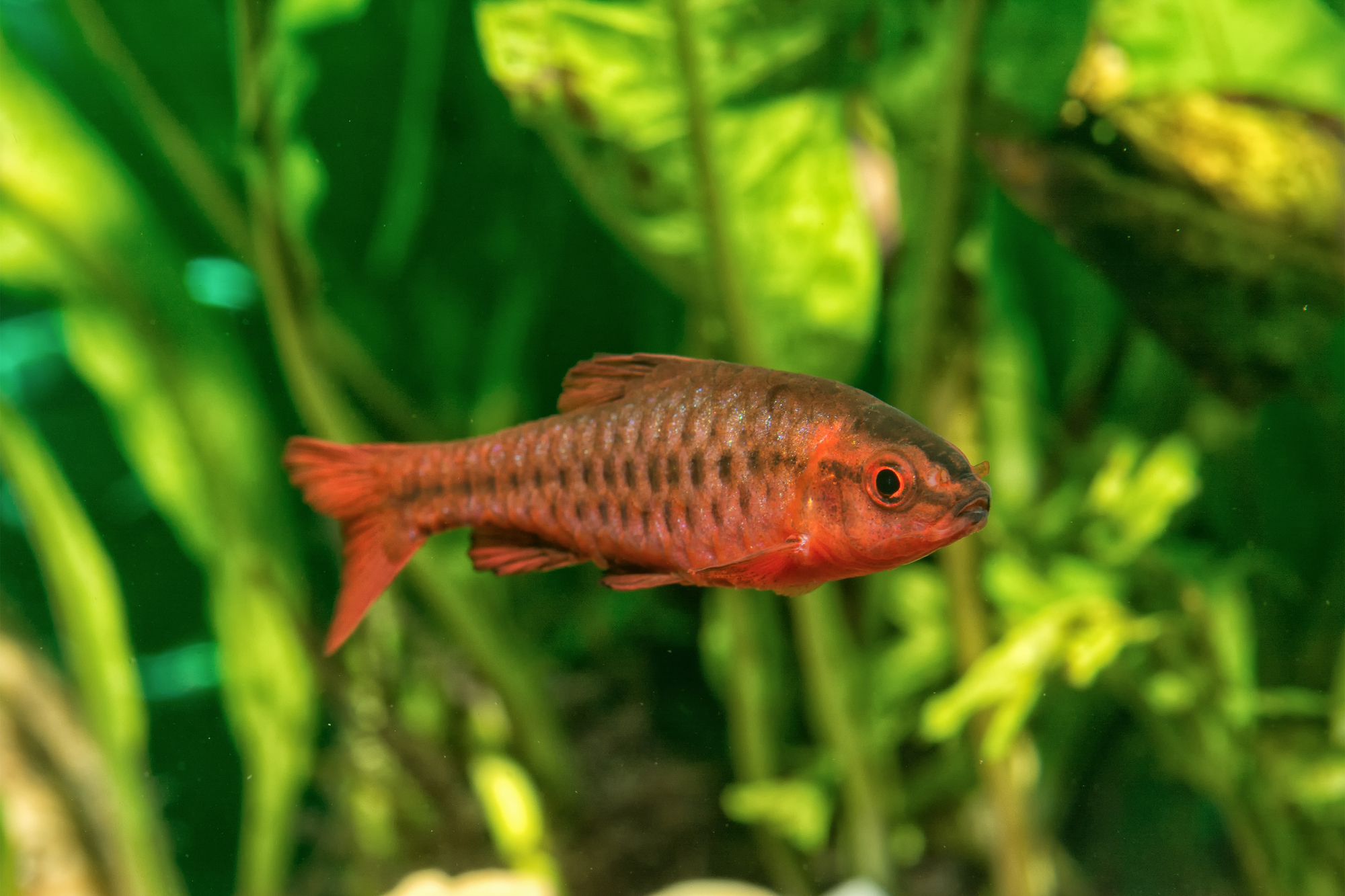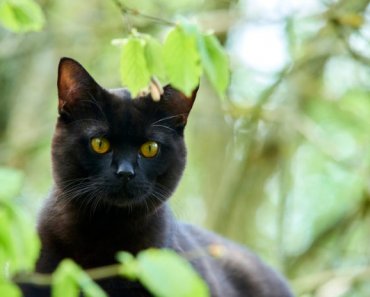If you’re a beginner and have a little bit bigger of a tank to start out with, then the cherry barb could make a great first addition. These peaceful fish have beautiful colors and do not require much extra care. However, they are schooling fish and will need to be kept in sizeable groups. But once put into a school, the true personality and colors of this species of barb make it all worthwhile.
Keep reading to find out everything you need to know about cherry barb care and keeping these freshwater fish in your own aquarium!
Name
Puntius titteya is commonly known as the cherry barb. Puntius titteya has also been described as Barbus titteya and Capoeta titteya throughout literature. The cherry barb most likely gets its common name from the bright red colors displayed by the male fish that resemble the fruit.
These fish are part of the Cyprinidae family which contains carps and minnows as well as barbs and barbels. This family of fish is actually the largest with about 3,000 documented species that are categorized into 370 specific genera. However, members of the Puntius genus are mainly found throughout South Asia, with the greatest concentration being in India.
Most of the species within Puntius do not exceed 2 inches (5.1 cm) in length with the exception of the largest reaching 10 inches (25.4 cm). As a whole, they are often referred to as “miniature carps” that are brightly colored; there are currently about 49 discovered species of Puntius.
Natural habitat
The cherry barb originates from Sri Lanka and is only found in and between the Kelani and Nilwala river basins. They prefer shaded streams with shallow and slow-moving water conditions. The substrate is primarily composed of silt and leaf detritus from the thick canopy above and submerged vegetation.
Due to their high demand as an aquarium fish, the wild populations of this barb are currently volatile and being monitored for further threats of overharvesting. This species has since become established in the Magdalena River basin in Colombia due to external releases and/or escapes. It is also believed that there may be a few rogue populations in Mexico and the Philippines, but numbers have not been reported or updated in recent years.

Identification
Cherry barbs are pretty easy to identify as not many other freshwater fish look that are currently available in the aquarium trade look like them. These fish have elongated bodies with short triangular fins with the caudal fin being forked in the center. Both male and female cherry barbs feature a darker mid-lateral line that runs from their nose to their caudal fin.
The cherry barb displays sexual dimorphism, which is when the males and females of a species differ in size and/or appearance. In the case of cherry barbs, male fish earn their name after their deep red coloration; male cherry barbs are also noticeably smaller and more slender than females. Females are a bit less colorful, though just as stunning with warm ambers and hues of red.
How big do cherry barbs get?
When fully grown, the cherry barb only grows to be about 2 inches (5.1 cm) long with male fish growing a little smaller. If kept in ideal tank and water conditions, these little fish can live to be about 3-5 years old!
Cherry barb tank requirements
While cherry barbs only grow to be about 2 inches (5.1 cm) long, they are quite an active schooling fish. This means that the tank will need to allow for at least 6 or more of these brightly colored fish to fully swim and exhibit their natural behaviors.
The minimum tank size for a school of cherry barbs is 30 gallons (113.6 L), with a longer aquarium being better than a taller one to allow for a more open swimming area. Otherwise, these fish do not require anything too specific in terms of tank setup.
Cherry barbs will especially stand out against a dark substrate and can be placed on either a gravel or sand substrate; for a really natural cherry barb ecosystem, a silt-like substrate should be used and intermixed with dried leaves, like Indian almond leaves.
These fish will also appreciate a heavily planted tank where the plants naturally create shaded areas throughout the display; floating plants may prove to be especially efficient in recreating these conditions. Additional hiding spots made from driftwood and rocks will make your cherry barbs feel all the more comfortable while replicating their preferred landscape; this may also help negate aggressive tendencies during spawning periods when males can become a little more dominant.
While the streams in Sri Lanka tend to have little to no water flow, hobbyists have found that these fish actually do better when there is some flow in the aquarium; most times, water flow from a filter is enough. In larger tanks, an additional powerhead may be needed to create enough water current to reach all areas of the aquarium.
Water parameters
Cherry barbs are pretty hardy and can withstand most tank conditions. They are tropical fish and will need to be kept in an aquarium with a stable water temperature between 74-80° F (23.3-26.7° C). They prefer neutral water and will need a pH between 6.0-7.0.
It should be noted that wild-caught cherry barbs may do better in more acidic water conditions; Indian almond leaves or other pH products can help achieve the desired level.
To find out more about what Indian almond leaves are used for and how they can benefit your aquarium, make sure to check out our full guide here!
Cherry barb tank mates
In general, cherry barbs are a very peaceful community fish that can be kept with an assortment of other species.
Tetras. Tetras may be the most popular fish to pair with cherry barbs as many species are just as colorful, peaceful, and active in a school. Some of the best tetra species that are cherry barb-compatible are: neons, black skirts, rummy noses, emperors, and lemon tetras.
Rasboras. These fish will also go together great with rasboras! Rasbora species grow to about the same size as the cherry barb and display the same schooling patterns. Harlequin rasboras pair especially well with their similar colors, but if you’re looking for more contrast then look for scissortail rasboras or galaxy rasboras. Chili rasboras may be a little too small to handle the activity that comes along with a cherry barb school and would probably do best in a species-only tank setup.
Corydoras. There are many species of Corydoras that could fit perfectly with your cherry barb school, especially since the minimum tank size is bigger than most community freshwater fish. It is important to look at each species of cory specifically to understand how large they get, their preferred area in the tank, and their level of activity. However, panda cories, bronze cories, and pygmy cories are all good species to consider for a tank with cherry barbs.
Swordtails. If you’re looking to bring a splash of color to the upper water column in your tank, then swordtails can make the perfect addition. These are active fish and will utilize the entirety of the aquarium to swim; they can be messy fish and produce a lot of waste so it is important that their minimum tank size is met to ensure enough room to swim and to handle bioload.
Gouramis. Gouramis can act as the showpiece for a cherry barb tank. These fish are a little bigger and can have beautiful coloration. Some species of gourami prefer to be in schools while others do best when only kept in pairs; some gouramis also tend to be more aggressive than others, so it is important to make sure that their temperament matches with your cherry barb. Some recommended species are honey gouramis and pearl gouramis (with special attention during spawning periods).
Otocinclus. If you have a mature planted tank and are struggling with keeping up with algae, Otocinclus catfish will handle most of the work for you. Otos are some of the best bottom feeders available in the aquarium trade today as they are completely peaceful and algae-hungry. These fish also like to school, so they will need to be kept in groups. Some hobbyists have also had difficulty upkeeping with their vegetarian diet once natural algae has been cleaned from the tank, so be prepared with multiple food options.
Cherry barbs. Yes, these fish actually need to be kept with themselves in order for them to display their best personalities and colors. If they are kept alone, they will mostly hide at the back of the tank and lose their color. However, it is important to create a balanced school so that aggression during spawning times is kept to a minimum. While male cherry barbs are more colorful than females and it might be tempting to only get males, this is unsustainable; it is recommended to get at least two females per ever male fish in order to lessen harassment.
But can a school of cherry barb be placed with a school of tiger barb (Puntigrus tetrazona)? Most likely not. While they both belong to Puntigrus, tiger barbs tend to be much more aggressive and likely to nip at fins than cherry barbs. It is best to stick with peaceful community fish for cherry barb tank mates than risk introducing more known aggressive species.
Cherry barb behavior
Cherry barbs are very peaceful fish, but can be very active when kept in appropriately-sized schools; they don’t tend to form tight schools, so they might take up more space than if you’re used to a tight-schooling tetra or other species; this is why it’s important to have plenty of room for your cherry barb to explore the middle and upper water columns of your aquarium.
While these fish are peaceful most of the time, males will become more aggressive during spawning periods. This aggression can be diluted by making sure that the tank is well planted, there are plenty of caves, and a good ratio between males and females is maintained.
Cherry barb diet
The cherry barb is an omnivore and will need to be fed a varied diet of both plant- and animal-based foods in order to stay its healthiest and most colorful.

What do cherry barbs eat?
As these fish come from areas covered in plant detritus, they are naturally inclined to pick as some algae and other waste around the aquarium. They can further be supplemented with algae pellets or wafers in the aquarium setting.
A good cherry barb diet will also consist of an assortment of live, frozen, and freeze-fried foods. Worms (bloodworms, cut-up earthworms, and Tubifex worms), brine shrimp, and insect larvae should be regularly offered. However, having a steady source of live foods can be risky and costly. Most hobbyists have taken it upon themselves to cultivate their own populations of brine shrimp, in particular, to ensure that there is always food available from a healthy and monitored source.
To read more about starting your own brine shrimp population, make sure to check out our full guide here!
Breeding cherry barbs
The cherry barb is a beautiful fish and pretty easy to breed; this makes them a good beginner fish for both the aquarium keeper and the aquarium breeder!
The cherry barb is an egg-scatterer which means that there is no particular method for laying eggs. This means that it would be best to move a pair of cherry barbs into a separate tank to monitor the spawning process; you will know that your cherry barbs are ready to spawn when colors intensify and the female becomes a little rounder.
This breeding tank should have the same water conditions as the display tank and dimly lit. An egg crate or other spawning mesh should line the bottom so that the eggs can fall through, but the adult fish cannot reach them (they will not hesitate to eat their own eggs!). Over the course of a few days, the pH should be lowered and the water temperature should be gradually increased in order to prompt spawning conditions.
Once the eggs have been laid, the male will fertilize them. As soon as this happens, the adult fish should be moved back to the display aquarium. Within 48 hours, the eggs should hatch and then become free-swimming shortly after that within the next day. The cherry barb fry should be fed small foods, like brine shrimp and microworms, until they are big enough to accept a larger variety of high-quality foods.
Once your fish start to resemble fully grown cherry barbs, it is time to rehome them to another hobbyist or introduce them into your display aquarium!
Conclusion
The cherry barb is one of the most popular fish in the aquarium trade overall; they are a peaceful community schooling fish with brilliant red colors. They do especially well in a planted tank that recreates their natural ecosystems in Sri Lanka while creating contrast with their stunning colors and providing additional hiding spots. Otherwise, these fish don’t require much more additional care and are tolerant of a wide range of water conditions.
If you have any questions about the cherry barb (Puntius titteya) or have kept these beautiful fish in your aquarium before, don’t hesitate to leave a comment below!

























